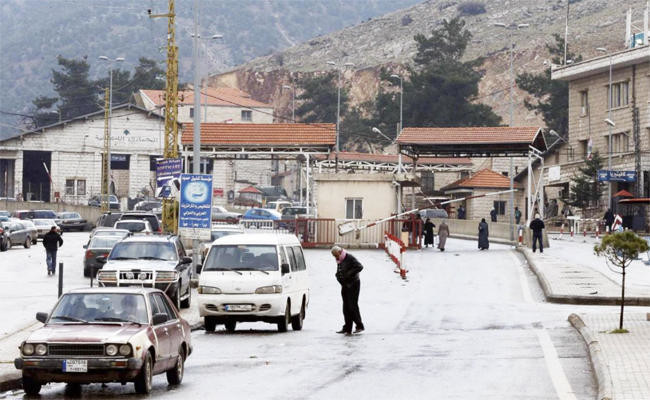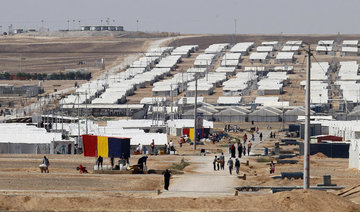DAMASCUS: Badr Honainy, a Syrian-Egyptian journalist based in Damascus, had spent days preparing for a job interview after being shortlisted for a sports editor job at the BBC.
But after waiting for hours at an official Syria-Lebanon border crossing, he was turned back without an explanation.
“This was a great opportunity for me,” said the disappointed 24-year-old.
As sanctions on Syria tighten, the only reprieve for its residents seems to be Lebanon. Attending embassy interviews, holding family reunions, sitting for international tests, joining training programs, and much more can only be done in Beirut.
However, with more than 1.5 million Syrian refugees flooding its borders since the civil war erupted in Syria in 2011, Lebanon has struggled to control the influx of refugees.
“I provided all the necessary documents and I have a journalist pass, an Egyptian passport, and a residency permit, yet I was treated badly by a few border officers and was not even given a chance to ask the smallest question,” said Honainy.
He was transferred to a security office but denied entry after waiting for hours.
“They refused to listen or provide me with alternative solutions,” he said.
“At the Masnaa Border Crossing, you notice that those who seem poverty-stricken are less likely to receive an entry permit because they seem very likely to stay in Lebanon as refugees,” according to a source who lives in Damascus and regularly visits Beirut.
People in fancy cars and elegant clothes are more likely to enter without complications, he said, “but sometimes even these are not lucky enough to enter in time for conducting their business.”
“Some 30 percent of the people in Lebanon at the moment are Syrian refugees, giving Lebanon one of the highest per capita refugee (populations) in the world,” Dr. David Romano, professor of Middle East politics at Missouri State University, told Arab News.
“Among Lebanese voters, who have lost patience with such a burden, restrictive policies toward the entry of Syrians seem like a popular option for the government.”
Some Lebanese officials also fear the entry of former Daesh fighters looking to escape Syria, he said.
“The casualties of this sort of Lebanese reaction, unfortunately, include average Syrians who only need to go to Lebanon for day trips to buy things and get things done that they cannot do in Syria, such as banking, getting visas and sitting for exams like the GRE (Graduate Record Examinations).”
Last month, Lebanese General Security announced plans to implement new controls to further restrict the entry of Syrians into Lebanese territory through the Masnaa Border Crossing, a land-based crossing linking the customs checkpoints of Masnaa in Lebanon and Jdeidat Yabous in Syria. The date on which the new restrictions take effect was not announced.
The new regulations classify Syrians’ entry into six categories, each requiring specific documents and are given a specific type of residence or entry permit.
Sami Jamal, 33, a Syrian living in Damascus who travels regularly to Lebanon, said: “The people of Syria are largely helping the Lebanese economy, be it through investments or tourism, yet Lebanon wouldn’t cease to seek creative ways to restrict our entry.”
Alia A, 31, travels to Beirut every two months to see her fiancé, who lives in the UAE.
For her tourist visa she needs to carry $1,000 and book a hotel room in Beirut in advance.
“Now I’ll have to carry $2,000 for the same trip and I don’t feel comfortable carrying all this cash,” she told Arab News.
“I cannot blame Lebanon,” Anas, 21, a computer engineering student at Damascus University, said. “Many of my friends who could not be exempted from the compulsory military service fled to Lebanon without plans. I cannot imagine how many people a country as small as Lebanon can accommodate.”
Armand Cucciniello III, a former American diplomat and adviser to the US military, told Arab News, said: “Lebanon is a frontline state in the war in Syria, so it’s natural that people are flocking to the border,”
“But the country is very small and lacks an effective government and resources—all the reasons that may be contributing to the pushback against more refugees.”
Cucciniello believes identity could also be at play here. “Most Syrians coming to Lebanon are reportedly Sunni, whereas the majority of Lebanon are Shiite or Christian,” he explained, “so any possible change in the country’s already troubled demographic could be a source of concern and recalcitrance on the part of border and immigration authorities.”
He pointed out that Lebanon took in hundreds of thousands of Palestinian “temporary” refugees after 1948, who eventually became militarized and played a role in the civil war that ravaged the country in the 1980s.
“The country does not have a positive collective memory, if you will, of refugees, which could be contributing to its reluctance to let in more,” he concluded.
Earlier this year, the head of the International Committee of the Red Cross (ICRC) in Lebanon, Christophe Martin, said “the majority of Syrian refugees in Lebanon want to return home.”
In 2017, the UN said that “the vast majority of the roughly one million Syrian refugees registered in Lebanon now find themselves impoverished and in debt, with levels of hardship increasing each year.”
“Lebanon lacks good infrastructure,” Cucciniello said, “and we’ve seen Syrian refugees set up camp over the years in areas where the local population, too, is struggling.”


Syrians stifled by Lebanon’s new entry restrictions
Syrians stifled by Lebanon’s new entry restrictions

Turkiye says contact with business jet carrying Libyan official

- Five passengers were onboard including the Libyan chief of general staff, General Mohammed Ali Ahmed Al- Haddad
ISTANBUL: Turkiye said on Tuesday it lost contact with a Falcon 50-type business jet with five passengers onboard including Libya’s chief of staff after it took off from the capital Ankara.
“Contact was lost at 20:52 local time (1752 GMT) with a Falcon 50-type business jet, tail number 9H-DFJ, departing from Ankara’s Esenboga airport bound for Tripoli at 20:10 local time,” Interior Minister Ali Yerlikaya said in a statement posted on X.
Five passengers were onboard including the Libyan chief of general staff, General Mohammed Ali Ahmed Al- Haddad, he added.
© 2025 SAUDI RESEARCH & PUBLISHING COMPANY, All Rights Reserved And subject to Terms of Use Agreement.














